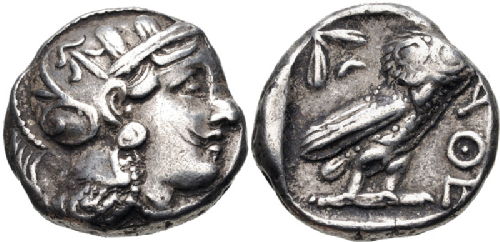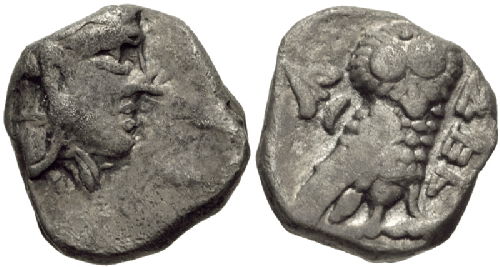All 1 entries tagged Yhd Coins
No other Warwick Blogs use the tag Yhd Coins on entries | View entries tagged Yhd Coins at Technorati | There are no images tagged Yhd Coins on this blog
November 01, 2013
The YHD Coins of Judah
 |
| Athenian Tetradrachm, 400-353 BC |
During the latter half of the fifth century BC, proud Athenians might have professed their coinage to be the world’s reserve currency; the ubiquitous ‘owls’ were recognised even in Persian-held territories. In the dying days of the Peloponnesian War, however, Athens found herself in both military and financial straits: to meet the costs of warfare, the citizens were reduced to plundering gold plate from the statues of Nike on the Acropolis, and the volume of newly-minted ‘owls’ entering circulation was drastically reduced. For undocumented reasons, a short time after, private and public individuals in the Persian satrapy of Judah began producing imitation coinage, featuring Athenian iconography.
Spot the Difference
Our two coins were both minted in the fourth century bc. The silver Athenian tetradrachm is an easily identifiable type: the well-defined helmeted head of Athena on the obverse; the owl, olive spray and the lettering ΑΘΕ [ΝAION] “of the Athenians” on the reverse. At first glance, the design on its counterpart, a Jewish obol, looks like a poor man’s copy. Athena’s features are somewhat oriental, and the owl has lost some fine detail. Perhaps Near Eastern die-engravers were unable to reproduce the Athenian images, or maybe, more likely, the need for a pixel-perfect replica simply didn’t exist. If official ‘owls’ were only required in the Near East and Transjordan for long-distance trading, any political significance of the images would have been lost – it was the worth of the metal that mattered.
 |
| Persian YHD coin of Judah, 375-332 BC |
The clearest difference between the two coins is the reverse legend, which on the Jewish coin, is written in paleo-Hebrew and reads YHD (sometimes YHWD). This name is used in the Bible when referring to the satrapy of Judah during the Persian period; also, it is found impressed upon the handles of contemporary jars excavated in Jerusalem. Hence, the legend is openly advertising the provenance of the coin: no one is trying to ‘pass off’ this owl as an Athenian original. Similarly, the replacement of the olive spray with a lily on the reverse signifies its foreign mint: the biblical temple built by King Solomon had pillars decorated with ‘lily-work’, the lily being a traditional symbol of Jerusalem.
Small Change
Over time, especially after the conquests of Alexander the Great, the yhd coin types altered. Without apparent repercussions, the Athenian owl was replaced by a falcon; the profile of Athena by a male head. Yhd coins were never, it seems, consistent with Athenian weight standards and denominations. So we are left with the question: when they began minting, why did the Persian satraps in Judah borrow from the Athenians at all?
The answer is probably to be found in the persistent conservative trend which pervades numismatic history: in order for people to accept that something IS money, it has to LOOK like money. Athenian owls were so widespread during the latter half of the fifth century that local changes to coinage design were necessarily small, in order to preserve wider confidence in the metal’s worth. We might update the idea by imagining the suspicious glance which greets a Scottish five-pound note in Cornwall today: perhaps it is akin to the reception of a newly-minted silver coin in Jerusalem 2400 years ago, although in the ancient case, a lily rather than a thistle gives the game away.
 This month's coin was chosen by Joe Grimwade, a second year undergraduate at the University of Warwick. He chose his 'Coin of the Month' after attending the British Museum's Numismatics Summer School, and is about to begin working with Warwickshire's Museum Service on their Roman coinage.
This month's coin was chosen by Joe Grimwade, a second year undergraduate at the University of Warwick. He chose his 'Coin of the Month' after attending the British Museum's Numismatics Summer School, and is about to begin working with Warwickshire's Museum Service on their Roman coinage.
Images above reproduced courtesy of Classical Numismatic Group Inc., (Electronic Auction 294, lot 306 and Electronic Auction 220, lot 194) (www.cngcoins.com)
 Clare Rowan
Clare Rowan

 Please wait - comments are loading
Please wait - comments are loading

 Loading…
Loading…

